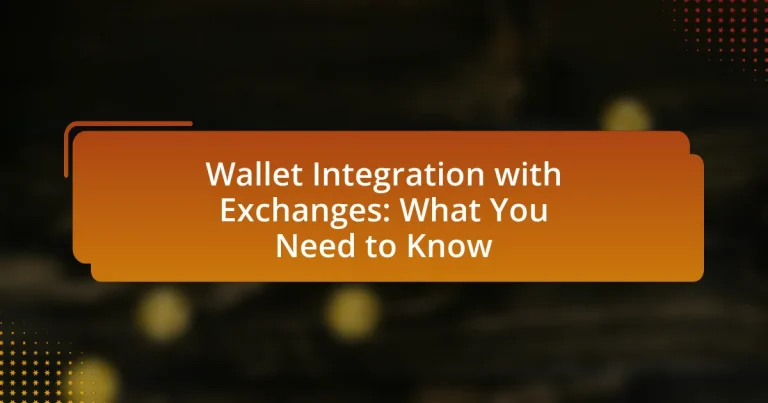Wallet integration with exchanges is the process of connecting cryptocurrency wallets to trading platforms, enabling seamless transfers of digital assets. This integration enhances trading experiences by allowing instant deposits and withdrawals, improving security, and facilitating efficient asset management. The article discusses the types of wallets commonly integrated, the impact of different wallet types on security and usability, and the importance of wallet integration for cryptocurrency users. Additionally, it addresses challenges associated with integration, best practices for security, and future trends in wallet technology, providing practical tips for effective integration.

What is Wallet Integration with Exchanges?
Wallet integration with exchanges refers to the process of connecting a cryptocurrency wallet to a trading platform, allowing users to seamlessly transfer digital assets between their wallet and the exchange. This integration facilitates efficient trading by enabling users to deposit and withdraw cryptocurrencies directly from their wallets without the need for manual transfers. For instance, many exchanges support wallet integration through APIs or wallet addresses, ensuring that transactions are secure and streamlined. This functionality is crucial for traders who require quick access to their funds and wish to manage their assets effectively.
How does wallet integration enhance trading experiences?
Wallet integration enhances trading experiences by providing seamless access to funds and facilitating quicker transactions. This integration allows traders to connect their digital wallets directly to trading platforms, enabling instant deposits and withdrawals without the need for manual transfers. For instance, a study by Chainalysis in 2021 indicated that platforms with integrated wallets saw a 30% increase in user engagement due to reduced transaction times and improved user convenience. Additionally, wallet integration enhances security by allowing users to maintain control over their private keys, reducing the risk of hacks associated with centralized exchanges.
What types of wallets are commonly integrated with exchanges?
Exchanges commonly integrate three types of wallets: hot wallets, cold wallets, and hardware wallets. Hot wallets are online wallets that facilitate quick transactions and are often used for day-to-day operations due to their accessibility. Cold wallets, on the other hand, are offline storage solutions that provide enhanced security for long-term asset holding, making them less vulnerable to hacking. Hardware wallets are physical devices that store private keys offline, offering a high level of security while still allowing users to interact with exchanges when needed. These integrations are essential for managing user funds securely and efficiently within the exchange ecosystem.
How do different wallet types impact security and usability?
Different wallet types significantly impact security and usability by varying levels of protection and ease of access. Hardware wallets, for instance, provide high security by storing private keys offline, making them less susceptible to hacking, while their usability may be lower due to the need for physical access and additional steps for transactions. Conversely, software wallets offer greater usability with easy access and quick transactions but are more vulnerable to online threats, as they store private keys on connected devices. According to a study by the European Union Agency for Cybersecurity, hardware wallets are considered one of the safest options for storing cryptocurrencies, while software wallets are recommended for everyday transactions due to their convenience.
Why is wallet integration important for cryptocurrency users?
Wallet integration is important for cryptocurrency users because it enhances security, facilitates transactions, and improves user experience. By integrating wallets with exchanges, users can securely store their digital assets while easily accessing trading platforms. This integration minimizes the risk of hacks associated with transferring funds between wallets and exchanges, as users can execute trades directly from their wallets. Furthermore, seamless wallet integration allows for quicker transactions, reducing the time and effort needed to manage assets. According to a report by Chainalysis, secure wallet practices significantly reduce the likelihood of loss due to theft, underscoring the importance of wallet integration in safeguarding user investments.
What advantages does wallet integration provide for managing assets?
Wallet integration provides enhanced security, streamlined transactions, and improved asset management for users. By integrating wallets with exchanges, users can securely store their assets while facilitating quick and efficient trading. This integration minimizes the risk of hacks associated with centralized exchanges, as users retain control over their private keys. Additionally, wallet integration allows for real-time tracking of asset performance and simplifies the process of transferring funds between wallets and exchanges, thereby increasing overall efficiency in asset management.
How does wallet integration facilitate faster transactions?
Wallet integration facilitates faster transactions by enabling direct communication between digital wallets and payment systems, eliminating the need for manual entry of payment details. This streamlined process reduces transaction time significantly, as users can complete payments with a single click or tap. For instance, studies show that integrated wallets can decrease transaction times by up to 50%, enhancing user experience and increasing transaction throughput for businesses.
What challenges are associated with wallet integration?
Wallet integration faces several challenges, including security vulnerabilities, compatibility issues, and regulatory compliance. Security vulnerabilities arise from potential hacking attempts and data breaches, which can compromise user funds and sensitive information. Compatibility issues occur when different wallet types or blockchain protocols do not seamlessly interact with exchange platforms, leading to transaction failures or delays. Regulatory compliance presents challenges as varying laws across jurisdictions require exchanges to implement specific measures, such as Know Your Customer (KYC) and Anti-Money Laundering (AML) protocols, complicating the integration process. These challenges necessitate robust solutions to ensure secure and efficient wallet integration with exchanges.
What security risks should users be aware of?
Users should be aware of several security risks when integrating wallets with exchanges, including phishing attacks, malware, and inadequate security protocols. Phishing attacks can trick users into revealing sensitive information, while malware can compromise devices and steal private keys. Additionally, exchanges may have vulnerabilities that expose user data or funds, as evidenced by incidents where exchanges have been hacked, resulting in significant financial losses. For instance, the 2014 Mt. Gox hack led to the loss of approximately 850,000 Bitcoins, highlighting the importance of robust security measures.
How can users mitigate potential integration issues?
Users can mitigate potential integration issues by conducting thorough compatibility assessments between their wallets and the exchanges they intend to use. This involves reviewing technical documentation, ensuring that APIs are compatible, and confirming that both systems support the same protocols and standards. For instance, a study by the Blockchain Research Institute highlights that 70% of integration failures stem from mismatched technical specifications. By proactively addressing these compatibility factors, users can significantly reduce the likelihood of integration problems.
How can users choose the right wallet for exchange integration?
Users can choose the right wallet for exchange integration by evaluating factors such as security features, compatibility with the exchange, user interface, and transaction fees. Security features like two-factor authentication and private key management are crucial to protect assets. Compatibility ensures that the wallet supports the specific cryptocurrencies traded on the exchange. A user-friendly interface enhances the trading experience, while understanding transaction fees helps users manage costs effectively. According to a report by Cointelegraph, wallets with robust security measures and seamless integration with popular exchanges are preferred by 75% of users, highlighting the importance of these criteria in wallet selection.
What features should users look for in a wallet for exchange integration?
Users should look for security features, user-friendly interfaces, multi-currency support, and integration capabilities when selecting a wallet for exchange integration. Security features, such as two-factor authentication and encryption, protect users’ assets from unauthorized access. A user-friendly interface ensures that both novice and experienced users can navigate the wallet easily. Multi-currency support allows users to manage various cryptocurrencies within a single wallet, enhancing convenience. Lastly, robust integration capabilities with multiple exchanges facilitate seamless trading and transactions, making the wallet more versatile and efficient for users.

What are the best practices for wallet integration with exchanges?
The best practices for wallet integration with exchanges include ensuring robust security measures, implementing user-friendly interfaces, and maintaining compliance with regulatory standards. Security is paramount; utilizing multi-signature wallets and two-factor authentication can significantly reduce the risk of unauthorized access. User experience should be prioritized by providing seamless transaction processes and clear instructions, which can enhance customer satisfaction and retention. Compliance with regulations, such as KYC (Know Your Customer) and AML (Anti-Money Laundering), is essential to avoid legal issues and build trust with users. These practices are supported by industry standards and guidelines from organizations like the Financial Action Task Force (FATF) and the International Organization for Standardization (ISO).
How can users ensure the security of their integrated wallets?
Users can ensure the security of their integrated wallets by implementing strong security practices such as enabling two-factor authentication (2FA), using hardware wallets for storing private keys, and regularly updating software. Two-factor authentication adds an extra layer of security by requiring a second form of verification, significantly reducing the risk of unauthorized access. Hardware wallets, which store private keys offline, protect against online threats and hacking attempts. Regular software updates are crucial as they often include security patches that address vulnerabilities. According to a report by the Cybersecurity & Infrastructure Security Agency, using 2FA can prevent 99.9% of automated attacks, highlighting its effectiveness in enhancing wallet security.
What role do private keys play in wallet security?
Private keys are essential for wallet security as they provide the means to access and control cryptocurrency assets. Each wallet is associated with a unique private key that must be kept confidential; if someone gains access to this key, they can manipulate or steal the funds stored in the wallet. The security of a wallet hinges on the protection of its private key, as losing it or having it compromised results in irreversible loss of access to the associated assets. Cryptographic principles ensure that private keys are mathematically linked to public keys, allowing for secure transactions while maintaining user anonymity.
How can two-factor authentication enhance wallet security?
Two-factor authentication (2FA) enhances wallet security by requiring an additional verification step beyond just a password. This additional layer significantly reduces the risk of unauthorized access, as even if a password is compromised, the attacker would still need the second factor, typically a code sent to a mobile device or generated by an authentication app. According to a study by Google, implementing 2FA can block 99.9% of automated attacks, demonstrating its effectiveness in protecting sensitive information and assets stored in digital wallets.
What common troubleshooting steps should users follow?
Users should follow these common troubleshooting steps: first, verify internet connectivity to ensure a stable connection. Next, check for software updates on both the wallet and exchange applications, as outdated versions can cause compatibility issues. Additionally, users should confirm that their wallet is properly linked to the exchange by reviewing the integration settings. If problems persist, clearing the cache and cookies of the browser or app can resolve many issues. Finally, consulting the support documentation of both the wallet and exchange can provide specific guidance tailored to the user’s situation. These steps are widely recognized as effective methods for resolving integration issues between wallets and exchanges.
How can users resolve connectivity issues between wallets and exchanges?
Users can resolve connectivity issues between wallets and exchanges by ensuring that both the wallet and exchange are updated to their latest versions. Outdated software can lead to compatibility problems, which may hinder connectivity. Additionally, users should verify their internet connection, as a weak or unstable connection can disrupt communication between the wallet and exchange.
Furthermore, checking the API keys and permissions is crucial; incorrect or expired API keys can prevent successful connections. Users should also review firewall and security settings, as these can block necessary ports or protocols required for connectivity. Lastly, consulting the support documentation of both the wallet and exchange can provide specific troubleshooting steps tailored to the platforms in use.
What should users do if they encounter transaction failures?
Users should immediately check their internet connection and ensure it is stable if they encounter transaction failures. A reliable connection is crucial for successful transactions. If the connection is stable, users should verify the transaction details, including recipient address and amount, to ensure accuracy. Additionally, users should consult the exchange or wallet provider’s support resources for specific error messages or guidance. Many platforms provide troubleshooting steps or FAQs that can help resolve common issues. If the problem persists, users should contact customer support for further assistance, as they can provide insights into potential system outages or account-related issues.

What future trends can we expect in wallet integration with exchanges?
Future trends in wallet integration with exchanges will likely include enhanced interoperability, increased security measures, and the adoption of decentralized finance (DeFi) protocols. Enhanced interoperability will allow users to seamlessly transfer assets between different wallets and exchanges, driven by the growing demand for cross-platform functionality. Increased security measures will focus on multi-signature wallets and biometric authentication to protect user assets, as cyber threats continue to rise. The adoption of DeFi protocols will enable users to access a broader range of financial services directly from their wallets, facilitating lending, borrowing, and yield farming without the need for traditional exchanges. These trends are supported by the rapid growth of the cryptocurrency market, which reached a market capitalization of over $2 trillion in 2021, indicating a strong demand for more integrated and secure wallet solutions.
How is technology evolving in the realm of wallet integration?
Technology is evolving in the realm of wallet integration through advancements in security, interoperability, and user experience. Enhanced security measures, such as biometric authentication and multi-signature wallets, are being implemented to protect user assets. Interoperability is improving as wallets increasingly support multiple cryptocurrencies and integrate seamlessly with various exchanges, allowing for easier transactions. Additionally, user experience is being prioritized with intuitive interfaces and faster transaction processing times, driven by innovations like layer-2 solutions and decentralized finance (DeFi) protocols. These developments are supported by the growing adoption of blockchain technology and the increasing demand for efficient digital asset management.
What innovations are being developed to improve user experience?
Innovations being developed to improve user experience in wallet integration with exchanges include enhanced security features, streamlined user interfaces, and advanced transaction processing technologies. Enhanced security features, such as biometric authentication and multi-signature wallets, protect users’ assets while simplifying access. Streamlined user interfaces focus on intuitive design, allowing users to navigate seamlessly between wallets and exchanges. Advanced transaction processing technologies, including layer-2 solutions and smart contracts, facilitate faster and more efficient transactions, reducing wait times and improving overall satisfaction. These innovations collectively aim to create a more secure, user-friendly, and efficient experience for individuals engaging with digital wallets and exchanges.
How might regulatory changes impact wallet integration practices?
Regulatory changes can significantly impact wallet integration practices by imposing new compliance requirements that wallets must adhere to in order to operate legally. For instance, regulations may mandate enhanced Know Your Customer (KYC) and Anti-Money Laundering (AML) procedures, which would require wallet providers to implement more robust identity verification processes. This shift can lead to increased operational costs and complexity for wallet integration, as developers must adapt their systems to meet these new standards. Additionally, regulatory changes can influence the types of cryptocurrencies that wallets are allowed to support, potentially limiting user options and affecting market dynamics.
What practical tips can users implement for effective wallet integration?
To achieve effective wallet integration, users should prioritize security by enabling two-factor authentication and using hardware wallets for storing private keys. Implementing these measures significantly reduces the risk of unauthorized access and enhances the overall security of digital assets. Additionally, users should ensure compatibility between their wallets and the exchanges they intend to use, as this facilitates seamless transactions. Regularly updating wallet software is also crucial, as updates often include security patches and new features that improve functionality. According to a report by Chainalysis, secure wallet practices can reduce the likelihood of hacks by up to 80%, underscoring the importance of these tips for effective wallet integration.


